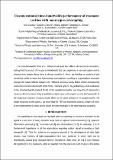Files in this item
Unconventional time-bandwidth performance of resonant cavities with nonreciprocal coupling
Item metadata
| dc.contributor.author | Cardea, Ivan | |
| dc.contributor.author | Grassani, Davide | |
| dc.contributor.author | Upham, Jeremy | |
| dc.contributor.author | Schulz, Sebastian Andreas | |
| dc.contributor.author | Tsakmakidis, Kosmas L. | |
| dc.contributor.author | Bres, Camille-Sophie | |
| dc.date.accessioned | 2021-02-02T10:18:09Z | |
| dc.date.available | 2021-02-02T10:18:09Z | |
| dc.date.issued | 2021-01-12 | |
| dc.identifier | 272646235 | |
| dc.identifier | d4d0a470-d692-4767-9f43-8cee5746b941 | |
| dc.identifier | 85100136237 | |
| dc.identifier | 000607479800006 | |
| dc.identifier.citation | Cardea , I , Grassani , D , Upham , J , Schulz , S A , Tsakmakidis , K L & Bres , C-S 2021 , ' Unconventional time-bandwidth performance of resonant cavities with nonreciprocal coupling ' , Physical Review. A, Atomic, molecular, and optical physics , vol. 103 , no. 1 , 013716 . https://doi.org/10.1103/PhysRevA.103.013716 | en |
| dc.identifier.issn | 1050-2947 | |
| dc.identifier.other | ORCID: /0000-0001-5169-0337/work/88267438 | |
| dc.identifier.uri | https://hdl.handle.net/10023/21354 | |
| dc.description | Funding: Hellenic Foundation for Research and Innovation (HFRI), General Secretariat for Research and Technology (GSRT) (No. 1819) (KLT). | en |
| dc.description.abstract | The time-bandwidth limit is a mathematical tenet that affects all reciprocal resonators, stating that the product of the spectral bandwidth that can couple into a resonant system and its characteristic energy decay time is always equal to 1. Here, we develop an analytical and numerical model to show that introducing nonreciprocal coupling to a generalized resonator changes the power balance between the reflected and intracavity fields, which consequently overcomes the time-bandwidth limit of the resonant system. By performing a full evaluation of the time-bandwidth product (TBP) of the modeled resonator, we show that it represents a measure of the increased delay imparted to a light wave, with respect to what the bandwidth of the reciprocal resonant structure would allow to the same amount of in-coupled power. No longer restricted to the value 1, we show that the TBP can instead be used as a figure of merit of the improvement in intracavity power enhancement due to the nonreciprocal coupling. | |
| dc.format.extent | 1344941 | |
| dc.language.iso | eng | |
| dc.relation.ispartof | Physical Review. A, Atomic, molecular, and optical physics | en |
| dc.subject | QC Physics | en |
| dc.subject | TK Electrical engineering. Electronics Nuclear engineering | en |
| dc.subject | T-NDAS | en |
| dc.subject.lcc | QC | en |
| dc.subject.lcc | TK | en |
| dc.title | Unconventional time-bandwidth performance of resonant cavities with nonreciprocal coupling | en |
| dc.type | Journal article | en |
| dc.contributor.institution | University of St Andrews. School of Physics and Astronomy | en |
| dc.identifier.doi | 10.1103/PhysRevA.103.013716 | |
| dc.description.status | Peer reviewed | en |
This item appears in the following Collection(s)
Items in the St Andrews Research Repository are protected by copyright, with all rights reserved, unless otherwise indicated.

